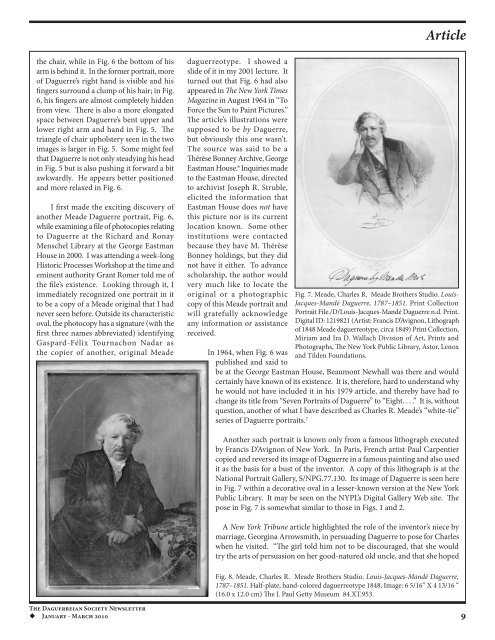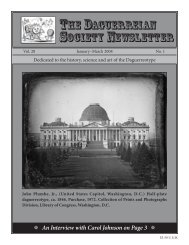THE DAGUERREIAN SOCIETY NEWSLETTER
THE DAGUERREIAN SOCIETY NEWSLETTER
THE DAGUERREIAN SOCIETY NEWSLETTER
You also want an ePaper? Increase the reach of your titles
YUMPU automatically turns print PDFs into web optimized ePapers that Google loves.
the chair, while in Fig. 6 the bottom of his<br />
arm is behind it. In the former portrait, more<br />
of Daguerre’s right hand is visible and his<br />
�ngers surround a clump of his hair; in Fig.<br />
6, his �ngers are almost completely hidden<br />
from view. �ere is also a more elongated<br />
space between Daguerre’s bent upper and<br />
lower right arm and hand in Fig. 5. �e<br />
triangle of chair upholstery seen in the two<br />
images is larger in Fig. 5. Some might feel<br />
that Daguerre is not only steadying his head<br />
in Fig. 5 but is also pushing it forward a bit<br />
awkwardly. He appears better positioned<br />
and more relaxed in Fig. 6.<br />
I �rst made the exciting discovery of<br />
another Meade Daguerre portrait, Fig. 6,<br />
while examining a �le of photocopies relating<br />
to Daguerre at the Richard and Ronay<br />
Menschel Library at the George Eastman<br />
House in 2000. I was attending a week-long<br />
Historic Processes Workshop at the time and<br />
eminent authority Grant Romer told me of<br />
the �le’s existence. Looking through it, I<br />
immediately recognized one portrait in it<br />
to be a copy of a Meade original that I had<br />
never seen before. Outside its characteristic<br />
oval, the photocopy has a signature (with the<br />
�rst three names abbreviated) identifying<br />
Gaspard-Félix Tournachon Nadar as<br />
the copier of another, original Meade<br />
daguerreotype. I showed a<br />
slide of it in my 2001 lecture. It<br />
turned out that Fig. 6 had also<br />
appeared in �e New York Times<br />
Magazine in August 1964 in “To<br />
Force the Sun to Paint Pictures.”<br />
�e article’s illustrations were<br />
supposed to be by Daguerre,<br />
but obviously this one wasn’t.<br />
The source was said to be a<br />
�érèse Bonney Archive, George<br />
Eastman House. 6 Inquiries made<br />
to the Eastman House, directed<br />
to archivist Joseph R. Struble,<br />
elicited the information that<br />
Eastman House does not have<br />
this picture nor is its current<br />
location known. Some other<br />
institutions were contacted<br />
because they have M. �érèse<br />
Bonney holdings, but they did<br />
not have it either. To advance<br />
scholarship, the author would<br />
very much like to locate the<br />
original or a photographic<br />
copy of this Meade portrait and<br />
will gratefully acknowledge<br />
any information or assistance<br />
received.<br />
In 1964, when Fig. 6 was<br />
published and said to<br />
Article<br />
Fig. 7. Meade, Charles R. Meade Brothers Studio. Louis-<br />
Jacques-Mandé Daguerre, 1787–1851. Print Collection<br />
Portrait File./D/Louis-Jacques-Mandé Daguerre n.d. Print.<br />
Digital ID: 1219821 (Artist: Francis D’Avignon, Lithograph<br />
of 1848 Meade daguerreotype, circa 1849) Print Collection,<br />
Miriam and Ira D. Wallach Division of Art, Prints and<br />
Photographs, �e New York Public Library, Astor, Lenox<br />
and Tilden Foundations.<br />
be at the George Eastman House, Beaumont Newhall was there and would<br />
certainly have known of its existence. It is, therefore, hard to understand why<br />
he would not have included it in his 1979 article, and thereby have had to<br />
change its title from “Seven Portraits of Daguerre” to “Eight. . . .” It is, without<br />
question, another of what I have described as Charles R. Meade’s “white-tie”<br />
series of Daguerre portraits. 7<br />
Another such portrait is known only from a famous lithograph executed<br />
by Francis D’Avignon of New York. In Paris, French artist Paul Carpentier<br />
copied and reversed its image of Daguerre in a famous painting and also used<br />
it as the basis for a bust of the inventor. A copy of this lithograph is at the<br />
National Portrait Gallery, S/NPG.77.130. Its image of Daguerre is seen here<br />
in Fig. 7 within a decorative oval in a lesser-known version at the New York<br />
Public Library. It may be seen on the NYPL’s Digital Gallery Web site. �e<br />
pose in Fig. 7 is somewhat similar to those in Figs. 1 and 2.<br />
A New York Tribune article highlighted the role of the inventor’s niece by<br />
marriage, Georgina Arrowsmith, in persuading Daguerre to pose for Charles<br />
when he visited. “�e girl told him not to be discouraged, that she would<br />
try the arts of persuasion on her good-natured old uncle, and that she hoped<br />
Fig. 8. Meade, Charles R. Meade Brothers Studio. Louis-Jacques-Mandé Daguerre,<br />
1787–1851. Half-plate, hand-colored daguerreotype 1848, Image: 6 5/16” X 4 13/16 “<br />
(16.0 x 12.0 cm) �e J. Paul Getty Museum 84.XT.953.<br />
The Daguerreian Society Newsletter<br />
"!January - March 2010 9




